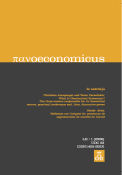The Nexus Between Household Consumption, Consumer Protection, and Consumer Confidence in European Countries. A Statistical-Mathematical Analysis
DOI:
https://doi.org/10.2298/PAN220825022FKeywords:
Consumer protection , Consumer confidence , Law enforceability , Household consumption , Mathematical methods for EconomicsAbstract
In this manuscript, the authors face the following research question: do consumer protection and consumer confidence have predictive power on household consumption? In order to provide an answer, the authors adopted a proper mathematical-statistical method. In particular, they collected cross-sectional data on 27 European countries and then estimated a consumption function accounting for both the Post-Keynesian Absolute Income Hypothesis and the Neoclassical Life-Cycle Hypothesis. This consumption function comprises, as a control variable, the Consumer Conditions Index, a measure of consumer protection calculated by the EU Commission. Moreover, the authors distinguished the effects on household consumption of three different aspects of consumer protection: Consumer knowledge of their rights and trust, Compliance and enforcement of consumer law, and Complaints and dispute resolution between consumers and retailers. The authors’ findings suggest that consumer protection may represent a transmission channel for consumer confidence.
JEL: C00, C21, E21, K00, K12.






